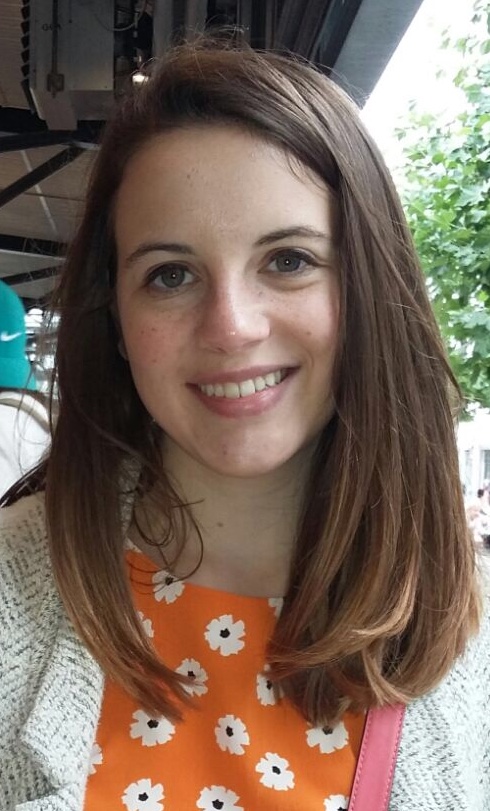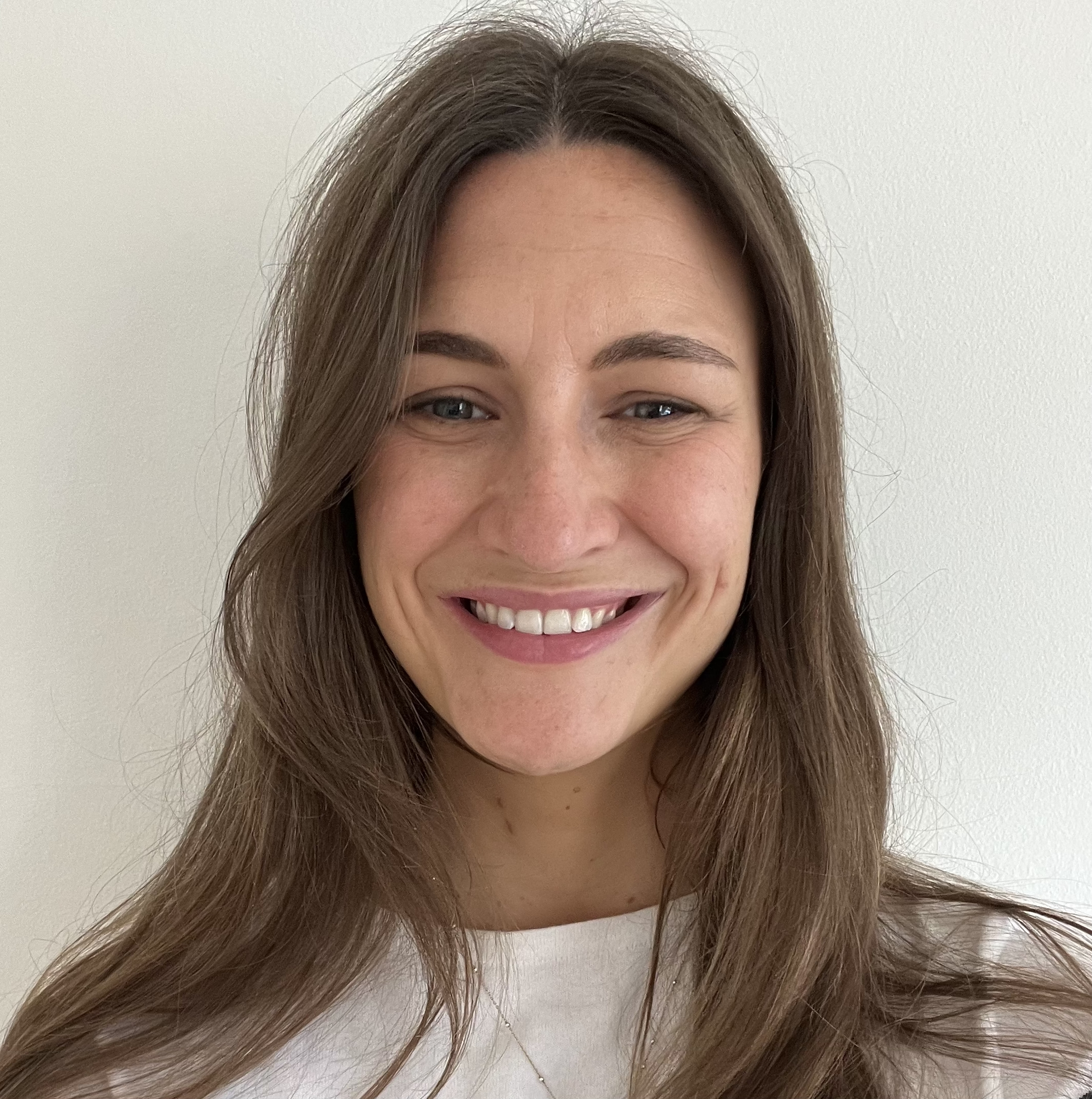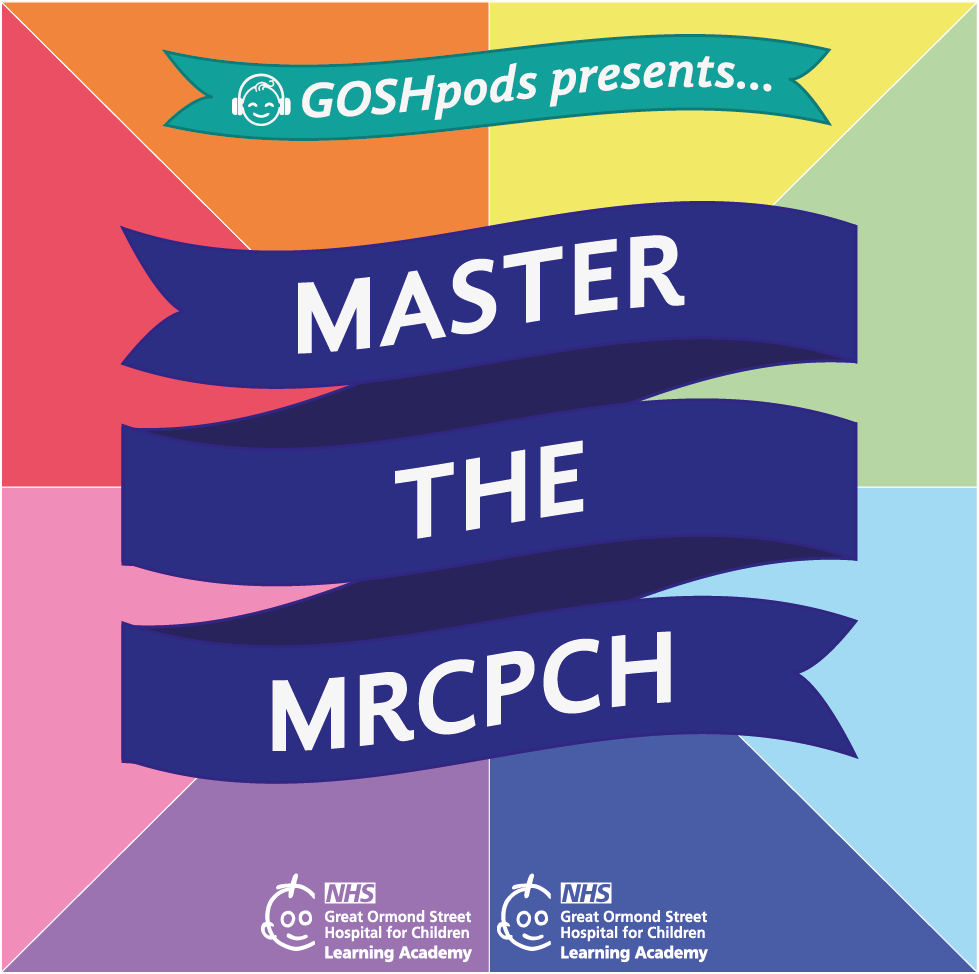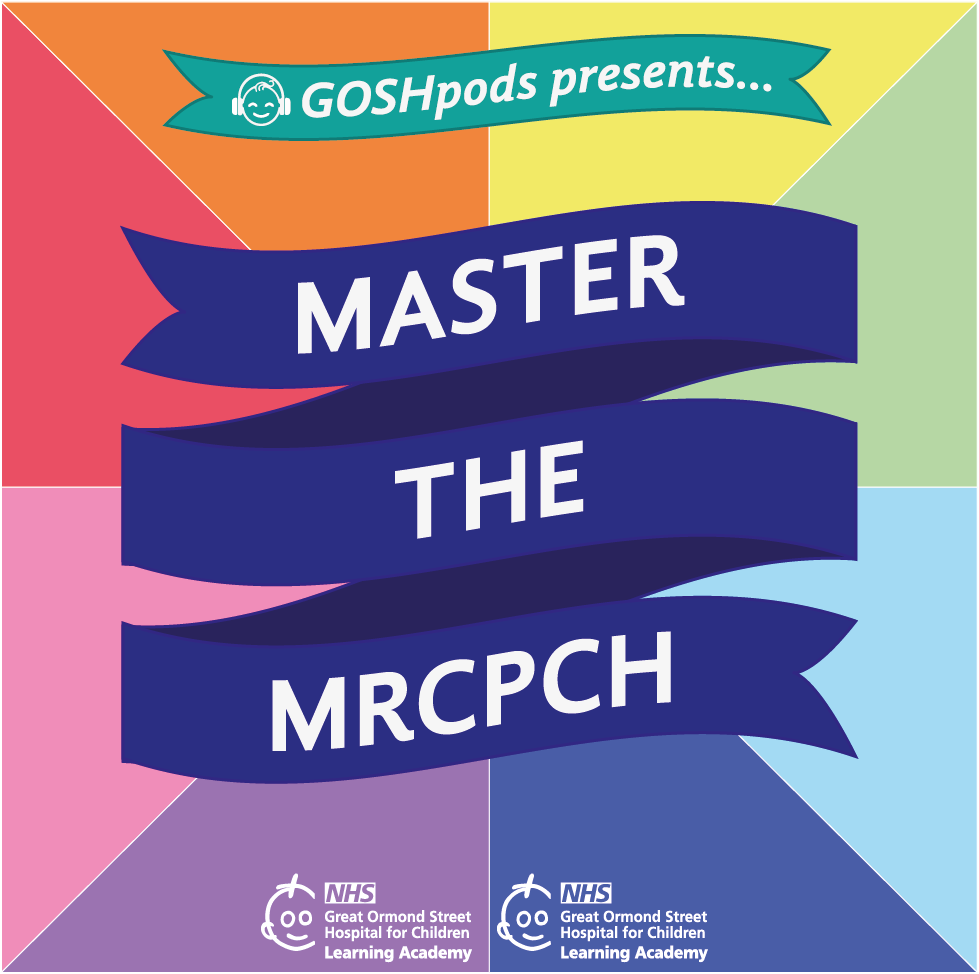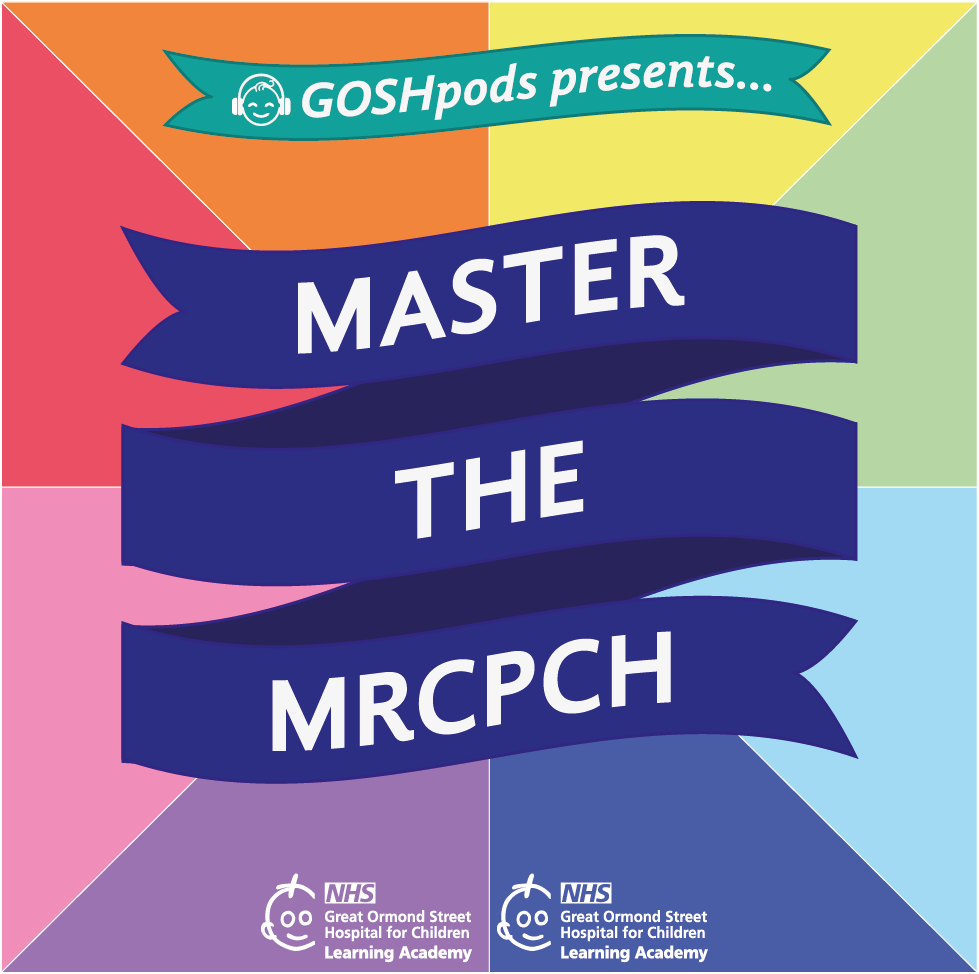This Podcast is brought to you by the GOSH Learning Academy.
SA: Hello, and welcome to Master the MRCPCH. In this series, we tap into the expertise here at Great Ormond Street Hospital to give you an overview of a topic on the RCPCH exam curriculum. So whether you're revising for an exam or just brushing up on a need to know topic, hopefully this podcast can give you the information that you need.
I'm Dr. Sarah Ahmed, a paediatric registrar and the current digital learning education fellow here at GOSH.
This is the second of a two part episode on shock. We're going to be talking with Dr. Andrew Jones, a consultant in the CATS Retrieval Service and a PICU consultant at Great Ormond Street Hospital.
Last time we talked about the definitions of shock and explored haemorrhagic shock and hypovolemic shock. In this episode, we're going to take the conversation further to talk about septic shock, neurogenic shock, and cardiogenic shock. Shock corresponds to the MRC PCH exam curriculum under the emergency medicine heading.
Andrew, in the first part of this episode, we spoke a little bit about haemorrhagic shock and hypovolemic shock. Can we move on to talk a little bit about septic shock, which is slightly different? Can you give us a definition for septic shock?
AJ: I can. So sepsis definitions. We could do a podcast series
SA: We absolutely could.
AJ: just on sepsis definition. We might not because I'm not sure the listener base would, would love it, but I will give you a sepsis definition. So sepsis is life threatening organ dysfunction caused by a dysregulated response to infection. And, and you could go further and say that septic shock is a subset of sepsis with particularly profound circulatory and cellular dysfunction.
But the definition of just sepsis, which I'll give you, life threatening organ dysfunction caused by dysregulated response to infection, that's probably enough. And you just have to accept that it's a spectrum, and there'll be some kids within that spectrum will have profound circulatory and cellular dysfunction.
When we talk about septic shock, this might be where the clinical classification of sepsis that I gave you falls down a little bit. Because within septic shock, there are elements of other types of shock. So it's a bit distributive. So distributive shock – neurogenic, anaphylactic and septic –is where you basically get blood vessel dilation, so the stagnant blood flow. Low systemic vascular resistance, so there's a big element of that in septic shock. There's also an element of hypovolemic shock because the capillaries leak fluid. So you lose fluid from the intravascular compartment. Also children with evolving severe sepsis might not be drinking or have high insensible losses. Or have diarrhoea and vomiting because their stomach is under perfused. There might be a bit of heart failure, cardiogenic shock as well, because the inflammation of sepsis suppresses myocardial function. And you might even get a bit of cytotoxic shock because the mitochondria are impacted upon by the inflammation and they can utilize the oxygen that they're delivered less well.
So within your umbrella of septic shock, there's quite a lot going on.
SA: It really does seem like there's a lot of overlap with these definitions that we've been talking about. All these different types of shock do really seem to be quite similar and yet distinctly different.
AJ: Yes, what you don't want is a classification that sort of gives undue attention to the very minor causes of shock. And then you have to cram all the other things into one category, to cram in your anaphylaxis, neurogenic and septic into your distributive. And you do want to classification, where there's a treatment pathway associated with each criteria.
SA: Well, then let's talk a little bit about the treatment pathway for septic shock.
AJ: Let's. So I think what I will, I'll describe the septic child or kind of an operational definition of what a septic child looks like, because actually it's not easy at all to diagnose sepsis, particularly amongst the sort of milieu of febrile children with benign self limiting illnesses. When they're febrile, they can look pretty rough and it's really hard to pick sepsis out of that.
But an operational definition would be suspected or proven infection. Plus, a child who is very hot or very cold, and we shouldn't forget, particularly in the smaller children, that sepsis can present with hypothermia. In fact, hypothermia can be a very worrying sign. A child who is inappropriately tachycardic, with an altered mental state, and reduced perfusion, or a prolonged capillary refill time.
So, suspected infection, plus a disturbance of temperature, inappropriate tachycardia, altered mental status, and reduced perfusion. And that is actually taken from Sepsis 6 which is the bundle in the UK based on current guidance, which I'm sure you and everybody else has come across.
So, treatment. Controversial things in here too. Some of this will be my opinion, some of it will just be what's in APLS. There are two major international consensus guidelines describing the management of sepsis in children. One is from 2017. It's called the American College of Critical Care Medicine Clinical Practice Parameters for Human Dynamic Support of Pediatric and Neonatal Shock and the 2020 Surviving Sepsis, which is a bit easier to remember.
They kind of say the same thing. Presented with a child with septic shock, you need to reverse the signs of septic shock as quickly as possible. And you should do that with fluid resuscitation as part of your ABCD assessment. Of course, give oxygen if needed, assess the breathing, address that. But in managing the circulation, you're looking to give somewhere between 20 and 60 ml per kilo of fluid, normal saline, or a balanced solution, in the first 15 minutes of presentation. In the American College of Critical Care Medicine guidelines, they actually say up to 40 to 60 mils per kilo in the first 15 minutes. In the latest iterations of APLS and in Sepsis 6, it talks more about going up to 20 mils per kilo before you start considering the next step.
I think it depends on the patient. You're constantly assessing response. The fluid boluses that you're giving are in theory 10 mils per kilo at a time. That's what APLS and what the Resus Council would tell you to do. If it is a very septic child, if the blood pressure is 40 over 20, the heart rate is 180, the lactate on the first gas is 10, you're effectively giving this fluid continuously because the 10 mils per kilo becomes a little bit academic. You've got one person as part of the resuscitation team with a big syringe, 50 mils you know, using all their effort to push it in into a 24 gauge cannula in the hand. But the key thing is constant assessment, looking for fluid responsiveness, and reversal of the signs of shock.
And then when you get to a point, 20, 40, 60 mils per kilo, I would probably go to more towards 40 or 60, then you need to start to think about the next step, fluid refractory shock. And that's when you have to start thinking about vasoactive drugs, vasopressors.
Now, of course, if you're faced with what is very clearly a very sick septic child, you can start to think about preparing that step, your vasoactive infusion right at the beginning.
SA: I think as part of that, let's bring in the discussion about the differences between warm shock and, and cold shock. How do those terms fit into what we've been speaking about?
AJ: Good question. Thank you for asking. People have heard of this, I think. And I'll give you a sort of framework to think about it, but I'll caveat the whole thing by saying that the difference between cold and warm shock is probably not that important to management and that actually clinically distinguishing between the two is quite difficult.
But what these two terms describe cold and warm shock is two distinct hemodynamic patterns. So what cold shock is, is a state of being very vasoconstricted, a high systemic vascular resistance and a low cardiac index. Cardiac index is your cardiac output as adjusted for your body surface area. So the pump isn't working very well. So it's a state of, I suppose, heart failure and vasoconstriction. And you can imagine because of the vasoconstriction and the poor heart pumping, the child could feel cold.
The warm shock is sort of the opposite of that. It is where the child, the patient will be very vasodilated with a low systemic vascular resistance and the heart, the cardiac output, the cardiac index is actually high. The heart is working overtime to compensate against vasodilation.
In paediatric practice, most community acquired sepsis is cold shock, vasoconstricted, with a heart that's struggling. Children with indwelling lines, PICC lines or Hickman's or whatever, who get line infections at home or in hospital, tend to present with warm shock, vasodilated, with a high cardiac output.
In adult practice, the predominant hemodynamic pattern of septic shock is warm shock.
This is the neat way of thinking about it. The complication is that you could put your hands on a child and they might feel very cold peripherally, but the deeper vascular beds might be quite vasodilated. So your clinical impression of whether it is cold or warm shock might be incorrect. And within the same illness, a child can move on the spectrum between these two states.
So I think in practice in the ED I wouldn't get too caught up on this. But what I think probably is a useful outcome from this is that we know that community acquired septic shock in children is probably going to be more like cold shock. There'll be some special circumstances, but usually cold shock. And in these cases, the vasoactive drug that we might like to use is adrenaline, because adrenaline is an inotrope, so it will help the ailing heart to pump more effectively. There's also a bit of a vasodilator as well at low doses, so it might cause a bit of vasodilation which might be useful.
So our practice is actually, usually, that community acquired sepsis, the little baby that comes in to ED, once we have reached the point where we've established fluid refractory shock, we want to start a vasoactive drug, and we would start adrenaline in the first instance. If we were very convinced we were dealing with warm shock, an older child perhaps, or a child with an indwelling device, they might have a low diastolic blood pressure, a surprisingly low diastolic blood pressure, because they're so vasodilated, we might decide to use noradrenaline as first line because noradrenaline is a drug that gives your arterial and venous system a squeeze. So to increase your SVR actually also increase your preload and that would improve your, your diastolic blood pressure.
But this is not hard and fast and a bit like which fluid to use, I think it's better to start something – adrenaline, noradrenaline, dopamine – rather than delay and sort of agonize about what to use.
SA: Yeah, absolutely. And we'll go on to talk a little bit about this in a sec, but I think if you've reached the point in a DGH where you're encountering fluid refractive shock, you're probably going to be talking to your retrieval team at that point. And then you can get their advice and guidance as well.
AJ: Absolutely agree. I'm not sure what the threshold for calling the transport team would necessarily be. I would say if you want to call, always call. I don't think the threshold can be too low, absolutely. But if you're resuscitating a child that you think has sepsis and you're at the 20 mils per kilo, you're giving two 10 mil per kilo boluses, they're still sick, I'd be calling at about that point for advice, and tee-ing up for possible transport.
SA: Absolutely. But I do like what you said about it's better to give something and to give nothing at all.
AJ: Yes, and actually, you know, kids are really severely shocked with sepsis, your classic sort of meningococcal septicaemia, although we don't see that much anymore, they end up on adrenaline and noradrenaline and having lots of fluid and having hydrocortisone and then maybe something else. And then the final part of the pathway, which is by no means straightforward, but considering ECMO. In septic shock that is refractory to fluid and then inotropes and then everything else you can throw at it.
SA: Yeah, absolutely.
*trumpet sounds* Did you know that GOSH runs mock exams for the MRCPCH?
Great Ormond Street has been running mock exams since June 2016. The mock is based on the MRCPCH clinical examination curriculum, and candidates are able to get the full experience and conditions of a real exam setting, and gain valuable feedback on their performance. To find out more go to the GOSH website and search MRCPCH exams.
Let's move on a little bit. So we've spoken about hypovolemic shock and haemorrhagic shock and septic shock. Let's move on to neurogenic shock, which is another type of distributive shock, but in my head is distinctive from the other ones in terms of its cause and its pathophysiology. So can you, tell us a little bit about neurogenic shock.
AJ: I will. I, you know, I can't tell you that I've seen a huge amount of it, actually. And will be relatively rare in children. Classically, it's a traumatic spinal injury above T6, which affects the sympathetic nerves. So, loss of sympathetic tone and sort of unopposed parasympathetic tone and that will lead to bradycardia and very dilated blood vessels. So it is distributive shock because you don't have enough volume within your blood vessels to perfuse your organs.
So trauma, traumatic spinal cord injuries is probably the big cause. There can be medical causes. This will be rare stuff, but Guillain Barre syndrome, other neuropathies, cervical subluxation in trisomy 21 could possibly cause this, transverse myelitis could probably cause this, anything affecting the spinal cord or brain stem above T6 ish level could do this. And it will present with hypotension, bradycardia and peripheral vasodilation.
But in the context of trauma, if a patient as a child is shocked, you should assume that it's blood loss before you assume it's this. Blood loss is likely to be, much more likely to be the cause of shock in a trauma patient than neurogenic shock. And then something to think about later.
If you think that you are faced with a child with neurogenic shock, bradycardic, vasodilated, hypotensive, then the approach would kind of be the same for any other shock, which is that you can try fluid. Although you might wonder how effective that would be, given the pathology. Although, that is the advice. I wouldn't go crazy with the fluid. Maybe something in the region of 20 40 mls per kilo and assess response. And then you're going to be looking to use a vasopressor. Probably something like noradrenaline to reverse the vasodilation, to directly reverse the pathology.
For the bradycardic aspect, there might be a role for atropine. These patients can be quite sensitive to suctioning, or rather when you suction them they get a parasympathetic surge and become bradycardia, bradycardic. So there might be a role for atropine there, there might be a role for pacing, overdrive pacing if they're very bradycardic, or drugs that you can give it as an infusion, which just increased the heart rate, isoprenoline, for example.
It's getting into quite small print niche stuff, I guess, at this stage. So I'd say, give some fluid, then use some noradrenaline. Apparently it, it can get better with time, sort of after six weeks you might see some resolution of those symptoms. There might be chronic problems like orthostatic hypotension in the long term.
This is rather getting out of my area of expertise.
SA: No, mine as well, absolutely. But definitely important to mention because it is one of those things that we learn about and it is a very rare cause, but bearing it in mind and picking it up when it does happen, I think is really important because I can see you being stuck in a situation where you think you've gone into fluid refractory shock, but actually the pathophysiology is different because it's caused by a neurogenic trauma instead.
AJ: Absolutely. And there's actually another confusing term around neurogenic shock, which is spinal shock.
SA: Oh yes, of course.
AJ: Spinal shock is a particularly unhelpful classification, but spinal shock is not shock at all in the terms that we've been talking about. It's not a failure of circulation, it's the sort of flaccid areflexia that may occur after a spinal cord injury. So a sort of stunning concussion of the spinal cord, and the neurological signs and symptoms that result from that. So you wouldn't give them fluid. Probably, unless they had neurogenic shock from the spinal cord injury as well, because they could coexist.
SA: We're absolutely getting very niche now. And I want to reassure people that this will not be coming up on your MRC PCH exam. I would really hope this does not come up on your MRC PCH exam.
The last type of shock that I think we should mention, but we're not going to go into a huge amount of detail about it is cardiogenic shock. Can you just give us a very brief overview of that?
AJ: It's another failure of circulation status of tissue and organ hypoperfusion, but caused by the hearts inability due to pump failure to deliver enough oxygen to organs and peripheral tissues to meet metabolic demands. And that's in the presence of an adequate intravascular volume. So it is the pump failing which is causing the oxygen delivery problem. Of course it could coexist with other forms of shock, and often does, but pure cardiogenic shock is just a pump failure.
It's, it's, I guess it is rare in children. If we think about congenital heart disease, that's not so rare one in a hundred children, babies will be born with a heart condition, although most of those will not have cardiogenic shock. Some will, hypoplastic left heart and things like that. And then there are the cardiomyopathies, the primary and secondary cardiomyopathies, which are also quite rare about one in a hundred thousand children. So this is reasonably rare stuff. And within cardiogenic shock, it is a broad broad category and the treatment will kind of depend on the underlying cause but it would include things like trauma, say a myocardial contusion, myocardial bruise, critical aortic stenosis and hyperplastic left heart or hyperplastic aortic arch. A low cardiac output state post cardiac surgery, arrhythmias like SVT or VT or JET post cardiac surgery, heart block when you have a very slow heart rate, that would cause cardiogenic shock, drug toxicity like an overdose of beta blockers, even hypocalcaemia from any cause, vitamin D deficiency, myocarditis from an enterovirus, cardiomyopathies like a dilated cardiomyopathy, which could be genetic. Or even something like ALCAPA where the coronary arteries are abnormal.
So this kind of a very long list, perhaps slightly overly long list, could all cause pump failure. And you'd probably address them all slightly differently.
SA: Yeah, I feel like this is a situation where you want to be talking to your, your cardiologist and your cardiothoracic surgeons and treating the cause as opposed to necessarily the symptoms.
AJ: Yes.
SA: I wanted to finish by talking a little bit about who treats shock. So most general paediatricians are going to see some form of shock in their DGH and everyone can start that initial treatment, but you work with the retrieval service in London, CATS and PICU at GOSH. At what point do you want the general paediatrician to be ringing you about these kids?
AJ: I'd say that there should be no barriers to referral. And the service that I work for, CATS Children's Acute Transport Service, which is the North London Regional critical care transport service, about half of our work is advice calls with half of our referrals are not transports. It's advice or decision support. And we exist in order to provide that. And I wouldn't give you a threshold for calling because we'd be happy to call about any case at any time. And if you're in a DGH and worrying about a patient or there's something you're not sure about, we exist for the purpose of helping with those decisions. And we can make a decision together. So we're always happy to be called. And so I wouldn't set a threshold so not to introduce a barrier.
I guess in the septic shock patients we were talking about 20 mils per kilo not resolved shock as a very broad rule would be fine to think about. But you can call earlier or you can call later. Depend on the patient, depend on the, the skillset of the team and the various competencies.
SA: That's really reassuring to hear that there is always someone on the other end of the phone if you need to get advice and guidance.
Let's round things up and I wanted to end with some quick fire questions. So firstly, are there any classic exam questions that might pop up about shock?
AJ: I, I had a little look at the practice exam papers and I could find one.
SA: Okay.
AJ: I dunno if, if you want to hear it or not?
SA: Yeah, let's hear it.
AJ: Do you? I won't make you answer it. So it's a 28 week gestation baby. Currently ventilated with a worsening metabolic acidosis over the last 24 hours. On examination his heart rate is 180 per minute and the mean blood pressure is 26. He has developed peripheral oedema. Due to bilious aspirates an abdominal x ray was performed. Now in the exam question there's a picture of the x ray and it looks like it looks like NEC. What is the most appropriate immediate management? Select one answer only. Oh, there's a blood gas actually. pH 7. 01, PCO2 5.5, PO2 8. 1, bicarb 10. 2, and base excess minus 17. So what is the most appropriate immediate management? A. Bicarb. You know my feelings on bicarb. B. Fluid resus. C. Increased ventilation. D. Needle aspiration of abdomen, E. Start IV antibiotics.
SA: Oh, they're going to take my letters away from me.
AJ: No, I'm not going to make you answer. So the answer, so the answer is, the answer is B fluid resus. I think, I think these single most appropriate management questions are quite hard because some of the answers, all of the, they give you answers which are all applicable. But I suppose in your A, B, C the ventilation's okay. They've told you about that. It's oxygenating all right. But the blood pressure's low with a not very good gas. So I think fluid resus first is what they're getting at.
SA: And I think what that question really highlights is you're not expected to know all the answers, at the stage of the MRPCH, what you're expected to be able to do is follow an ABCDE to start treatment and to know when to go and get help.
AJ: yes.
SA: But I am also going to go back and have a look at that question and do some, do some clinical reasoning for my own, my own working out.
So secondly, and you've mentioned a couple already, but are there any useful resources that you would recommend?
SA: Yes. So when I'm approaching a topic, I kind of have a three stage website process. This is really revealing the secrets of a consultant life. Like I have, if I have to prepare a presentation or prepare something like this, I'll use Up To Date to look at epidemiology and background, it's quite a good scene setter, Up To Date. And then this website, which I mentioned already called Deranged Physiology, which is just, it's actually beautifully written, quite funny, and has lots of detail. Deranged Physiology, I will go to to try and understand the physiology. And then I use another website or two, a couple of websites. There's something called Life in the Fast Lane which is an adult ICU website, but it's highly applicable to paeds. Very thorough compendium of topics. And, and Don't Forget The Bubbles for a paediatric slant on things. And if you just use those three things, I think you can pretty much learn anything.
SA: Yeah, I really love that approach actually. And Don't Forget The Bubbles is one that I would second as well. I think it gives really accessible overviews and introductions to a lot of the topics that you would face in emergency medicine related to pediatrics.
AJ: Yeah, absolutely. And it'll reference all the important contemporary guidelines.
SA: Yeah. And it always looks really pretty as well. They put a lot of effort into their into their digital presence.
AJ: Yeah, it's great.
SA: Finally, Andrew, what are your takeaway learning points?
AJ: My takeaway learning points. I'd be familiar with the definition of shock and the classification. You don't have to use my classification. And you can I'm happy to take criticism and feedback on it. Nachos plus. But be familiar with some sort of classification of shock.
I would say that the key to all of this is index of suspicion, early recognition, prompt management. You can apply that to everything that we've talked about. Referring to contemporary guidelines on management if you need to, and making use of your local paediatric critical care transport service for advice and then transport if needed.
SA: Andrew, thank you so very much for coming on and having a chat with us today. It's been really illuminating and really helpful.
AJ: Thank you for having me, really enjoyed it.
SA: Thank you for listening to this episode of Master the MRCPCH. We would love to get your feedback on the podcast and any ideas you may have for future episodes. You can find link to the feedback page in the episode description, or email us at digital
[email protected]. If you want to find out more about the work of the GOSH Learning Academy, you can find us on social media, on Twitter, Instagram, and LinkedIn. You can also visit our website at www.gosh.nhs.uk and search Learning Academy. We have lots of exciting new podcasts coming soon. So make sure you're subscribed wherever you get your podcasts. We hope you enjoy this episode and we'll see you next time. Goodbye.
